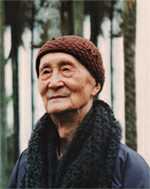Views
Yìnshùn 印順 (1906-2004)
|
| Notable Associates: |
Yìnshùn 印順 (1906-2004) was perhaps the most respected Chinese scholar-monk during the latter half of the 20th century.
Contents |
Biography
Yìnshùn studied at both traditional academies and at modern schools growing up. His father had him study Chinese medicine when he was young. He was tonsured Qīngniàn 清念 under at Fúquán Hermitage 福泉庵 on Pǔtuóshān 普陀山 in 1930. He received full ordination later in November under Yúanyīng 圓瑛 at Tiāntóng Temple 天童寺. After ordination he enrolled at the Mǐnnán Buddhist Seminary 閩南佛學院. At the request of the school's principle, Dàxǐng 大醒, he went and taught at the Gǔshān Buddhist Seminary 鼓山佛學院 for a semester, where he met Xūyún 虛雲 and Cízhōu 慈舟. After half a year, he returned to the Mǐnnán Buddhist Seminary, where he studied for several years.
Eventually, Yìnshùn decided to study the scriptures by himself. Qīngniàn helped him get established in the Scripture Hall at Huìjì Temple 慧濟寺 on Pǔtuóshān. After several years he went to the World Buddhist Studies Center 世界佛學苑 in Wǔchāng 武昌 where he studied Sānlùn 三論 texts. In 1936, Tàixū 太虛 asked him to advise students in that school of thought at the Wǔchāng Buddhist Seminary 武昌佛學院.
In 1938, Yìnshùn fled the Second-Sino Japanese War by moving to Chóngqìng 重慶, where he immediately began teaching at the Sino-Tibetan Institute 漢藏教理院. Notable students of his at the time included Yǎnpéi 演培. In the fall of 1941, Yǎnpéi was asked by Tàixū to start the Fǎwáng Buddhist Seminary 法王佛學院 in Héjiāng 合江, Sìchuān 四川. Yǎnpéi invited Yìnshùn to come serve as guiding teacher, which he did until 1944. Around this time Xùmíng 續明 became Yìnshùn's close associate.
After the end of the War, Yìnshùn and his students made their way east across the devastated landscape. Along the way there were briefly guests of Kāng Jìyáo 康寄遙 in Xī'ān 西安. They finally arrived in Shànghǎi 上海 in January 1946. They paid homage to Tàixū at Yùfó Temple 玉佛寺, then followed his orders to establish the Wǔlín Buddhist Seminary 武林佛學院 in Hángzhōu 杭州.
After Tàixū's death on March 12, 1947, Yìnshùn and Xùmíng edited the Tàixū dàshī quánjí 太虛大師全集. In October of 1948, they were invited by Xìngyuàn 性願 to help oversee ordinations at Nánpǔtuó Temple 南普陀寺 in Xiàmén 夏門. Yìnshùn stayed and started a lecture series, but by the middle of 1949 the Civil War forced him and several of his associates to flee to Hong Kong 香港.
In Hong Kong, Yìnshùn moved from place to place. He sought to establish hermitages and lecture series, and a few were successfully carried off. After representing the R.O.C. at an international Buddhist meeting in Japan, he settled in Táiwān 台灣, and became abbot of Shàndǎo Temple 善導寺. He also took over editing the Hǎicháo yīn 海潮音 after the death of Dàxìng. He left Shàndǎo Temple in 1957 and settled at Fúyán Hermitage 福嚴精舍 in Xīnzhú 新竹.
Important Works
- Huáyǔ jí 華雨集
- Miàoyún jí 妙雲集
- Yìnshùn wrote a huge number of works during his life. Some of these can be accessed at:
Notable Students
Notes
References
- Yú Língbō 于凌波, ed. Xiàndài Fójiào rénwù cídiǎn 現代佛教人物辭典 (A Dictionary of Modern Buddhist Persons), 2 vols. Taipei: Foguang, 2004. Pp. 1.295b-298a.
